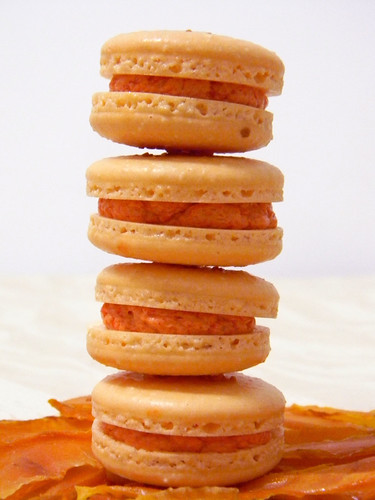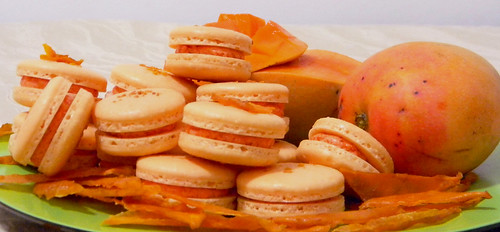
Yes, still on macarons.. seems that I would never get rid of the bugs. This time... flavored with mango. I see that mango will be in season soon; well, it's already started. Since it's a native plant, we can find so many varieties... with name or without name. The one without name, of course the least desired... sour and fibrous. Only a few people like them, including me. Well, basically I like mangos whatever the taste... sour, sweet, juicy, or fibrous... doesn't really matter to me. My husband has his own names for different mangos he can find in the market... common mango (Harum Manis; easy to find everywhere), starchy mango (Indramayu) , fragrant fibrous mango (Kweni), aromatic mango (Gedong Gincu), yellow mango (Manalagi), sour mango (Semar), and so on and so on, which sometimes confuse me... and confuse himself! for there are too many varieties. Yes, as a foreigner in this country, all those local names are too difficult for him to remember; he named them based on their characteristics. Sometimes, in fruit stores, we can find imported mangos from Thailand or from Australia. But of course we like our mangos better, the local varieties have richer flavor than those imported one, and much cheaper too. I often wonder what kind of people buy those imported mangos...
In the office, Atiah brought some green mangos almost every week. She has one mango tree in her front yard... a Gadung mango tree... what a blessing.
My favorite mangoes are Gedong Gincu, Harum Manis, and green mango (unripe mango) from whatever variety. I also love Kesturi mango from Kalimantan. I used to eat Kesturi mango in my childhood when we lived in South Kalimantan. That was in 1970's. Kesturi mango is endemic plant in that province. In every mango season, my Mom and Dad went to villages in South Kalimantan looking for this particular kind of mango, and would buy them directly from the tree. It's so aromatic and sweet, small size around 7cm long and 5cm thick, and so fibrous. The skin is dark purplish green, covers the dark orange fibrous flesh. Since it's so fibrous, not many buy and plant Kesturi, and it becomes more and more difficult to find. In 1980's the local government tried to promote this endemic plant, but not much has been achieved until now. Kesturi is still hard to find. Gedong Gincu is aromatic but not as aromatic as Kesturi, and less fibrous.
To flavor macarons, I need the most aromatic mango I can find, which is Gedong Gincu. Last week I oven-dried some Gedong Gincu mango (see my post on oven-dried fruits), which the flavor I love so much. It was so intense! I process some in my food processor, trying to make powdered mango. But I couldn't make it fine, so it looked more like mango bits. Maybe I didn't dry it enough. Never mind. I mixed 25 grams of it in the almond-powdered sugar mixture, and resulted in macawrongs...
This is the pictures... they look perfect, but... I trick you! they have big air pockets!!
See the big airpocket under the surface?
Yes, those mango bits inside the macarons shells were not dry and fine enough. Taste-wise? yummy! and sooooo mango!
The next batch was plain macarons colored in orange, with some mango bits on top of the shells. They look nice, with just enough Gedong Gincu flavor from the mango bits. To add more mango flavor, I decided to make the filling using Gedong Gincu mango puree, mixed with swiss-meringue buttercream. Yum. Love the flavor a lot. Next time, I will take care on oven-drying the mango, make sure it's really dried and fine, and see how it will end up with.
Manggo Mancarons
(Make 25-30 macarons)
For the shells :
120 g ground almond
200 g powdered sugar
100 g egg-whites
30 g caster sugar
Orange food coloring
10 g mango bits
Mix the ground almond and powdered sugar using food processor, put aside.
Whisk the egg-whites in medium speed until foamy, add the caster sugar, continue whisk until stiff. Be careful not to over-whisk.
Add the almond-sugar mixture to whisked egg-whites in three additions and the food coloring as well.
Mix (macaronage) until a lava-like consistency, then put in a big piping bag with a round nozzle tip.
Pipe 2.5 cm diameter rounds on silpat/parchment paper lined baking tray. Knock the baking tray on a hard surface several times to remove the bubbles. Sprinkle the mango bits on top of the shells. Let rest for 30 minutes.
Preheat oven to 160 celsius degree.
Double the baking tray, and bake the macarons shells for 20 minutes.
Let it cool first before removing them from the silpat/parchment paper.
For the filling :
Mango Puree
180 g mango, cut in small cubes (from 1 small mango)
20 g caster sugar
If you want a perfectly smooth puree, use blender or food processor. But I like small soft chucks and fibers here and there, so I simply cut the mango in small cubes.
Mix the mango with sugar in a small saucepan, and boil with low heat for about 20 minutes. Stir often to prevent burning. It is to evaporate the liquid and to make a thicker puree. Set aside to cool.
Makes around 130 grams.
Mango Buttercream
(Adapted from Tartelette)
100 g caster sugar
2 (70 g) egg-whites
180 g unsalted butter, room temperature
130 g mango puree
2 tbsp of brandy (optional)
In a bowl, mix the egg-whites and sugar.
Using double boiler, over a simmering water, heat the mixture and continuously whip until hot and cloudy like a soft marshmallow (around 3-5 minutes).
Transfer to a stand mixer and continue whisking in medium-high speed until cool, thick and shinny.
Change to a paddle attachment and in medium speed, add butter one tablespoon at a time. Continue until soft.
Mix in the mango puree and brandy.
Put in a piping bag, and use to fill the macarons.
To assembly :
Pair the macarons shells of the same size.
Pipe the mango filling on one and top with the other.
Keep in an air-tight container in the fridge for 24 hours to blend the flavor. It will taste much nicer. Trust me.
Enjoy.




No comments:
Post a Comment